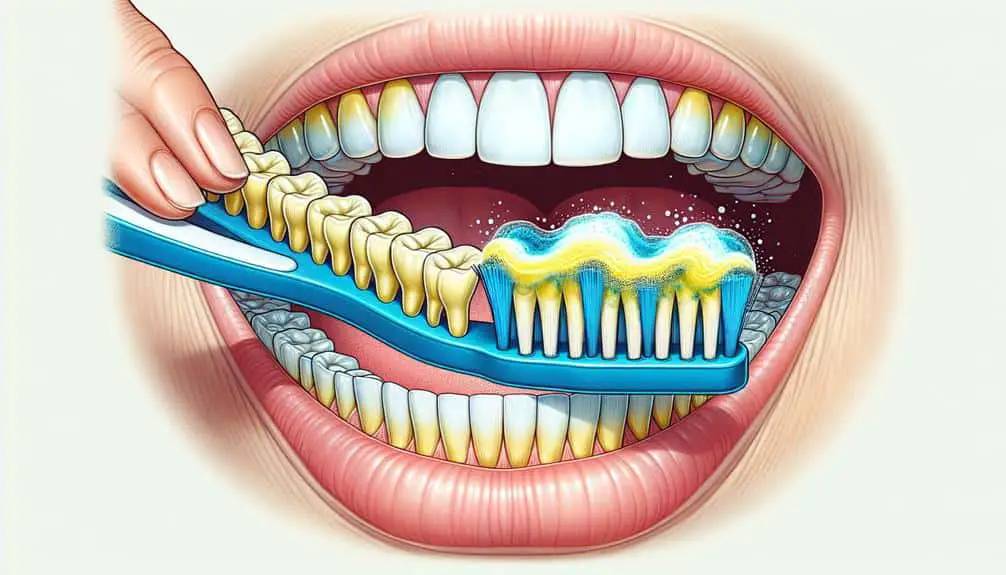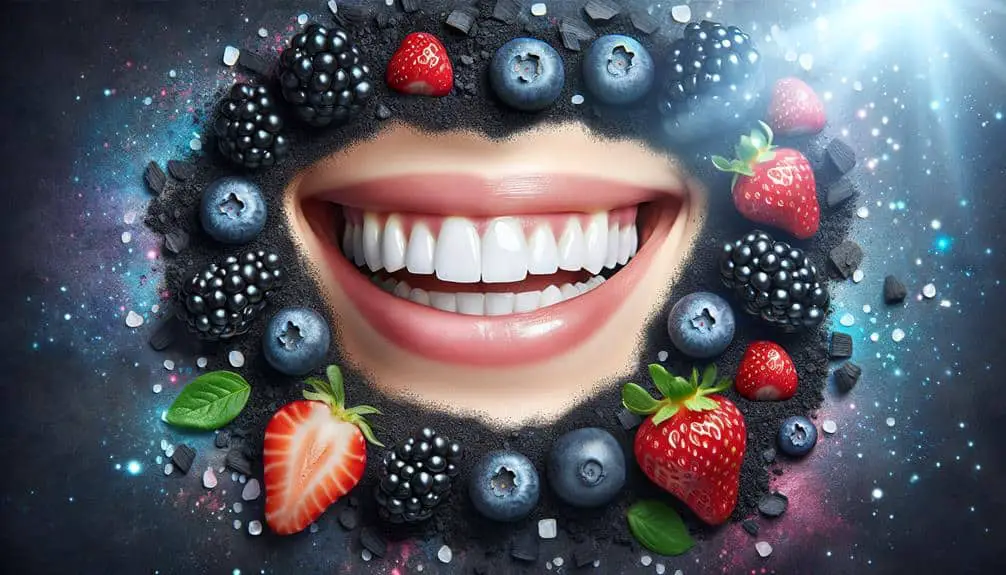To effectively address old fluoride stains, specialized whitening solutions are needed due to their deep-seated nature. These stains penetrate enamel deeply, requiring targeted treatments for removal. Advanced whitening solutions break down chemical bonds within the enamel to lift stubborn discolorations. Professional whitening procedures offer stronger agents that can effectively combat tough stains, ensuring thorough stain removal. The effectiveness of whitening solutions hinges on their ability to penetrate enamel pores and remove stains at a molecular level. Understanding these mechanisms is key to achieving lasting results in enhancing both appearance and oral health.
Key Points
- Fluoride stains alter enamel structure, requiring specialized solutions for removal.
- Deep-seated stains penetrate enamel, necessitating advanced whitening techniques.
- Whitening solutions break down chemical bonds in enamel to lift stains.
- Professional options like dental bleaching offer stronger agents for tough stains.
- Effective removal of old stains enhances oral health and appearance.
Causes of Old Fluoride Stains
To understand the causes of old fluoride stains, it's important to explore the chemical reactions that occur within the tooth structure over time. Fluoride discoloration, often seen as yellow or brown spots on the teeth, is a result of prolonged exposure to high levels of fluoride during tooth development. The long-term effects of this exposure lead to the incorporation of fluoride ions into the hydroxyapatite crystals that make up the tooth enamel. As a result, the crystalline structure of the enamel is altered, causing changes in light reflection and absorption, which manifest as stains.
The process of fluoride incorporation into the enamel is a gradual one, occurring over years of exposure. As the fluoride ions replace hydroxide ions in the enamel crystals, the tooth becomes more resistant to decay but also more prone to discoloration. Understanding these chemical mechanisms is vital for developing effective whitening solutions specifically tailored to address old fluoride stains. By targeting the root cause of the discoloration, these solutions can provide lasting results and restore the natural aesthetics of the teeth.
Challenges in Whitening Old Stains
Exploring the chemical complexities of old fluoride stains reveals the inherent challenges in effectively whitening these deep-seated discolorations. Persistent discoloration caused by long-term exposure to fluoride can penetrate deep into the enamel, making it difficult to remove through regular dental hygiene practices. These deep-seated stains are often resistant to traditional whitening methods due to their stubborn nature.
The challenges in whitening old stains lie in the ability to break down the accumulated fluoride deposits without causing damage to the tooth structure. The chemical composition of these stains requires specialized whitening solutions that can effectively target and lift the discoloration from within the enamel pores. Standard whitening treatments may not be sufficient to address the depth of these stains, necessitating more advanced techniques.
To effectively combat the deep-seated nature of old fluoride stains, dental professionals may recommend professional whitening procedures that utilize stronger concentrations of whitening agents. These targeted solutions can penetrate the enamel to lift the persistent discoloration, restoring the natural brightness of the teeth. Understanding the challenges posed by these deep-seated stains is essential in developing effective whitening strategies for best results.
Effectiveness of Whitening Solutions
The effectiveness of whitening solutions in addressing deep-seated fluoride stains relies heavily on their ability to penetrate and lift the stubborn discolorations from within the enamel pores. Whitening technology plays an essential role in this process, as it determines the depth to which the stains can be reached and removed. These solutions work by breaking down the chemical bonds that hold the stains in place, allowing them to be lifted out of the enamel structure. It's important to note that the longevity of the whitening effect can vary depending on the concentration of the active ingredients and the individual's oral health habits.
Achieving successful stain removal not only enhances the appearance of your teeth but also contributes to your overall oral health. By eliminating deep-seated stains, whitening solutions can help prevent further discoloration and maintain the integrity of your enamel. This improvement in the aesthetics of your smile can also boost your confidence, leading to a more positive self-image and potentially improving your social interactions.
Professional Whitening Options
Consider professional whitening options for a more effective and lasting solution to address deep-seated fluoride stains. Dental bleaching, a common procedure in cosmetic dentistry, offers a powerful method to whiten teeth affected by stubborn fluoride stains. This process involves using a bleaching agent, usually hydrogen peroxide or carbamide peroxide, to break down the stains and lighten the teeth.
Professional dental bleaching is a controlled and supervised treatment that guarantees safety and best results. Unlike over-the-counter products, professional whitening options provide stronger bleaching agents that can penetrate deeper into the enamel to target tough stains. Additionally, the personalized approach of professional whitening allows the dentist to tailor the treatment to your specific needs, considering factors like the severity of the stains and your overall oral health.
Home Remedies for Stained Teeth
To address stained teeth at home, you can explore holistic remedies and DIY treatments that may help enhance the appearance of discoloration on your teeth. Holistic remedies such as baking soda and hydrogen peroxide can be effective in removing surface stains on teeth. Baking soda, when mixed with water to create a paste, acts as a gentle abrasive that can softly scrub away stains. Hydrogen peroxide, commonly found in whitening toothpaste, has bleaching properties that can help lighten stains on the teeth.
Another DIY treatment for stained teeth is oil pulling with coconut oil. This involves swishing coconut oil around in your mouth for about 15-20 minutes to reduce bacteria and plaque that can cause discoloration. Additionally, incorporating crunchy fruits and vegetables like apples and carrots into your diet can help naturally scrub away surface stains on your teeth.
While these home remedies can help enhance the appearance of stained teeth, it's crucial to consult with a dentist for a thorough evaluation of your oral health and to determine the most suitable treatment option for your specific needs.
Frequently Asked Questions
Can Old Fluoride Stains Be Completely Removed With Whitening Solutions?
Like a skilled painter restoring a masterpiece, whitening solutions can effectively lift old fluoride stains, offering lasting results. However, the efficacy may vary for deeply ingrained, aging stains, requiring patience and consistent application.
Are There Any Potential Risks or Side Effects Associated With Whitening Old Fluoride Stains?
When considering whitening old fluoride stains, be cautious as potential risks like tooth sensitivity or gum irritation may occur. Long term effects and safety concerns should be monitored, so consult a dental professional for guidance.
How Long Does It Typically Take to See Results When Using Whitening Solutions on Old Stains?
How long does it take to see results when whitening old stains? It varies based on the severity of the stains and the whitening solution used. Typically, noticeable improvement can be seen within a few weeks. Maintenance is essential for long-lasting results.
Are There Any Specific Dietary or Lifestyle Changes That Can Help Prevent the Recurrence of Fluoride Stains After Whitening?
To prevent fluoride stain recurrence after whitening, consider dietary modifications and lifestyle changes. Avoid excessive fluoride exposure from water or dental products. Use home remedies like oil pulling. Maintain good oral hygiene and visit your dentist regularly for preventive measures.
Can Old Fluoride Stains Be a Sign of Underlying Dental Health Issues That Need to Be Addressed by a Dentist?
Old fluoride stains can indicate underlying dental health issues. Proper dental hygiene is essential to prevent these stains. Regular check-ups with a dentist can help identify and address any underlying problems that may be contributing to the staining.



